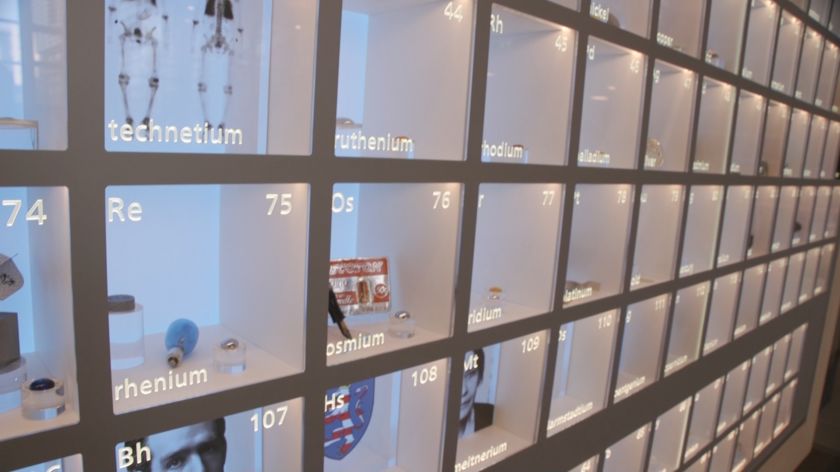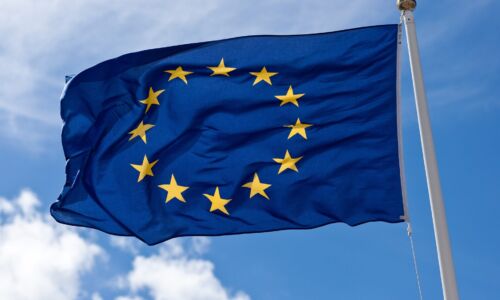Close encounters with the elements in the Huygens Building
-
 Foto: Leoni Andriessen
Foto: Leoni Andriessen
A platinum razor blade. Radium paint on an alarm clock. Fragments of various metals. If you’ve ever wondered what chemical elements actually look like in their natural state, you'll love the ‘real life’ periodic table in the entrance hall of the Huygens Building.
Einstein, Copernicus, Marie Curie. Breeze past the brightly lit portraits of these scientists in the entrance hall of the Huygens Building, and you might think it’s some kind of tribute to the historic giants of science. But pause for a moment, and you’ll soon realise it’s something else entirely: a life-size version of the periodic table of elements.
The wall-mounted display is made up of around 120 sections with mostly two-letter abbreviations like ‘Au’ or ‘Pt’ and a few numbers. Many of us will recognise this periodic table from chemistry lessons at secondary school. Each abbreviation represents an element – such as gold or platinum – with the numbers representing what’s known as the atomic number. ‘These are the building blocks for everything around us,’ explains Professor of Synthetic Organic Chemistry Floris Rutjes, as we stand in front of the display. ‘Whether you’re on planet Earth or at the other end of the universe, everything around you is made up of these elements.’
Bill Gates
It was a Russian scientist, Dmitri Mendeleev, who first organised the elements and created the periodic table in 1869. The table is usually shown in the form of a poster, so it’s quite special to have such a beautiful wall-mounted display like this one in the Huygens Building, says Rutjes. (Bill Gates apparently has a similar one in his study.) Each 15cm by 15cm section contains a genuine, physical piece of the element described. For example, the section for atomic number 24 (Cr) has a fragment of chrome, and number 82 (Pb) has some dark-grey lead. And yes, the shimmering substance in number 79 is a real sheet of gold.
That’s why the display was not exactly cheap – more than 10,000 euros, says Rutjes – but what you get in return is a uniquely vivid representation of the elements. ‘Chemistry is an abstract science,’ he explains. ‘You might never see the materials you work with in their pure form, because they’ll be mixed with other elements in an alloy, for example.’ But here in the entrance hall of the Faculty of Science you can admire them in their full splendour. It’s as educational for visitors on open days as it is for students and researchers.
Dish of uranium glass
Rutjes, who is also the director of the Institute for Molecules and Materials at the Faculty of Science, led the process of installing the pale-blue display. The entrance hall already featured other eye-catching displays, including one related to physics (the 10-metre high Foucault’s pendulum, which demonstrates the Earth’s rotation) and to mathematics (a bronze Möbius strip). Rutjes felt that chemists deserved a display of their own. While attending a conference, he met the Zutphen-based entrepreneur Christiaan Schriks of Stardust Elements, who had already made a few similar periodic table displays. Schriks was happy to make another one for the Faculty of Science.
The display even includes radioactive materials, such as uranium. This element can be found in section 92, where it lends colour to a small dish. ‘See that shade of pale green?’ says Rutjes, pointing to one of the lower sections. ‘That dish is made of uranium glass. As late as the 1930s, you could still have had one of those. People thought it was so pretty. It also happens to glow in the dark.’
Potassium and sodium are submerged in oil, to prevent they ignite
The dish is kept behind lead glass to block the very faint radiation. ‘The Occupational Health & Safety and Environmental Service did want some details about these objects,’ says Rutjes, with a smile. ‘But everything is safely displayed in accordance with the rules.’ These rules also apply to potassium and sodium, for example, which are submerged in oil in a hermetically sealed capsule. That’s because these materials can ignite when they come into contact with air or water.
Nobel Prize
And the pictures of scientists like Einstein? They’re displayed in the sections for the elements named after them: einsteinium, copernicium, curium. These materials are so unstable that they only exist for a fraction of a second before decaying into lighter elements. They can only be produced in special particle accelerators.
A touchscreen next to the display provides more information on all the elements for anyone interested in learning more about them. This includes information on the elements themselves, or on research being carried out at the Faculty of Science, such as on neodymium. There’s also information on graphene, a special form of carbon, for which professors André Geim and Kostya Novoselov won the Nobel Prize in 2010. But Rutjes has noticed that the display also inspires non-scientists. ‘A historian colleague pointed out that the photo shown for promethium isn’t the Greek god Prometheus at all,’ he laughs. ‘It’s actually an image of Ajax.’



